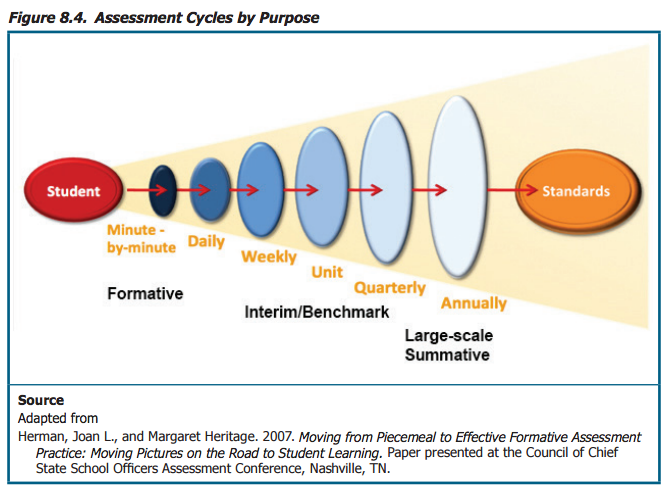Guiding 2016-17 CAASPP Activities
Author: Rick Phelan
Published: 11.12.16
 As schools advance work in the 2016-17 school year, it’s wise to plan specific actions focused on California Assessment of Student Progress and Performance (CAASPP) tasks. Along with delivering the Smarter Balanced ELA and mathematics tests for grades 3-8 and 11, schools will also be piloting the new California Science Test. The California Science Test pilot will be administered to all students in grades 5 and 8 along with one assigned grade at the high school level. This blog post shares steps which can support readiness and positive student outcomes.
As schools advance work in the 2016-17 school year, it’s wise to plan specific actions focused on California Assessment of Student Progress and Performance (CAASPP) tasks. Along with delivering the Smarter Balanced ELA and mathematics tests for grades 3-8 and 11, schools will also be piloting the new California Science Test. The California Science Test pilot will be administered to all students in grades 5 and 8 along with one assigned grade at the high school level. This blog post shares steps which can support readiness and positive student outcomes.
Step 1: High Altitude CAASPP View Take a ‘high altitude’ look at the 2016-17 school year from the perspective of CAASPP. SCOE has developed a sample district plan outlining activities for tech support staff, students, teachers, and administrators through the lense of CAASPP. The high altitude view provides a monthly outline of actions for schools. The document can be adapted or modified to suit district needs and is available as either a Word or PDF file.
Step 2: Review 2016 End of Year Results
Schools are encouraged to reflect on their 2015-16 results involving local measures, portfolios, exhibitions and end of year summative assessments. To help with review of 2016 SBAC results, schools can look in a number of different places:
Ed Results Partnership
http://www.edresults.org/PreK12
EdSource Smarter Balanced Results
https://edsource.org/smarter-balanced-results/search_schools.html
CAASPP Test Results
http://caaspp.cde.ca.gov/sb2016/Search
Overall results should be considered along with significant subgroup information. When reviewing SBAC data, educators should consider the following questions:
- Did students have enough time to practice on the form and format of the test?
- Did students get the right supports and accommodations?
- Is the achievement gap different comparing ELA and mathematics?
- How can the variables of curriculum, instructional strategies and/or time be considered in relation to outcomes? Should any of the variables be adjusted?
- Can the disaggregated data for EL and formerly EL students provide additional insight?
- Are there instructional programs that seem to be more effective than others?
Along with these questions, educators are encouraged to look at ELA and math grade level results focusing on:
- Achievement Level Descriptors
- Claims, Targets & Standards
Check out the 2016 Guide for Smarter Balanced Reporting along with resources from the California Department of Education for more ideas and information on analyzing results.
Step 3: Articulate 2016-17 Outcomes & Formative Assessment Check Points
School faculties, parents and students are encouraged to have a “team” approach when thinking about learning outcomes for 2016-17. Ideally, all members on the team should feel informed and work in concert to support 2016-17 goals. Starting points involving students and parents are offered through through the following resources:
Educators should be gauging learning progress throughout the year. This graphic from the California ELA/ELD Framework offers perspective on this work:

The California State Board of Education offers two specific tools to aid all California public school educators in this work:
- Smarter Balanced Digital Library- tools and practices designed to help teachers utilize formative assessment processes for improved teaching and learning in all grades
- Interim Assessments- Designed to inform and promote teaching and learning by providing information that can be used to monitor student progress toward mastery of the California Standards
Educators can obtain access to the SBAC Digital Library and Interim Assessments through their District Assessment & Accountability Coordinator.
Step 3: Integrate Technology Tools as Part of Daily Instruction
Technology can play a key role helping students access and express understanding of California Standards. The Fresno County Office of Education produced a document titled, “Recommended Digital Literacy & Technology Skills to Support the California Common Core State Standards,” to help educators see connections. Teachers are encouraged to marshall technologies that offer efficient and effective grade level learning opportunities for students. In doing this educators frequently discover technology resources can provide alternative learning pathways. Some of these can be found in open education resources providing alternative text, audio, and video. In addition, there are also alternate ways of expressing learning through technology including multimedia presentation tools, recorded text, and extensions to Google Chrome. A sample ‘alternate learning path’ can be found in this 4th grade student’s California Mission project using Minecraft. Work in these areas frequently has direct connections with Smarter Balanced Usability, Accessibility and Accommodation Guidelines. In other words, using technology in daily instruction helps students be prepared for the technology based Smarter Balanced Summative Assessment.
Upcoming Professional Development Opportunities in Sonoma County
Preparing for CAASPP Summative Assessments- January 18, 2017
http://www.scoe.org/pub/htdocs/class.html?class_id=6787
2016-17 CAASPP Institutes- February 2 & 3, 2017
https://goo.gl/cMjv5v
Blog: Technology for Learners

